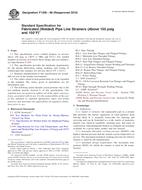Potrebujeme váš súhlas na využitie jednotlivých dát, aby sa vám okrem iného mohli ukazovať informácie týkajúce sa vašich záujmov. Súhlas udelíte kliknutím na tlačidlo „OK“.
ASTM F1398-93(2012)
Standard Test Method for Determination of Total Hydrocarbon Contribution by Gas Distribution System Components
Automaticky preložený názov:
Štandardná skúšobná metóda pre stanovenie celkového uhľovodíkov Príspevok plynovú distribučnej sústavy komponenty
NORMA vydaná dňa 1.7.2012
Informácie o norme:
Označenie normy: ASTM F1398-93(2012)
Poznámka: NEPLATNÁ
Dátum vydania normy: 1.7.2012
Kód tovaru: NS-50153
Počet strán: 10
Približná hmotnosť: 30 g (0.07 libier)
Krajina: Americká technická norma
Kategória: Technické normy ASTM
Kategórie - podobné normy:
Anotácia textu normy ASTM F1398-93(2012) :
Keywords:
components, contamination, gas distribution, hydrocarbon analyzer, hydrocarbon contribution, hydrocarbon outgassing, semiconductor processing, ICS Number Code 23.040.01 (Pipeline components in general. Pipelines)
Doplňujúce informácie
| Significance and Use |
|
3.1 The purpose of this test method is to define a procedure for testing components being considered for installation into a high-purity gas distribution system. Application of this test method is expected to yield comparable data among components tested for purposes of qualification for this installation. |
| 1. Scope |
|
1.1 This test method covers the testing of components for total hydrocarbons (THC) contribution to a gas distribution system at ambient temperature. In addition, this test method allows testing of the component at elevated ambient temperatures as high as 70°C. 1.2 This test method applies to in-line components containing electronics grade materials in the gaseous form, such as those used in semiconductor gas distribution systems. 1.3 Limitations: 1.3.1 This test method is limited by the sensitivity of current instrumentation, as well as by the response time of the instrumentation. This test method is not intended to be used for components larger than 12.7-mm (1/2-in.) outside diameter nominal size. This test method could be applied to larger components; however, the stated volumetric flow rate may not provide adequate mixing to ensure a representative sample. Higher flow rates may improve the mixing but excessively dilute the sample. 1.3.2 Different instrumental methods (such as flame ionization detector (FID), mass spectrometer (MS)) will yield total hydrocarbon (THC) levels that are not comparable due to different sensitivities to different molecular species. Hydrocarbon contaminants of high-purity gas distribution systems can be subdivided into two general categories: ( 1) noncondensable hydrocarbons (<C4), that are present due to difficulty of removal and relative atmospheric abundance, and (1.3.3 Because of the tremendous disparity of hydrocarbon species, it is suggested that direct comparisons be made only among data gathered using the same detection method. 1.3.4 This test method is intended for use by operators who understand the use of the apparatus at a level equivalent to six months of experience. 1.4 The values stated in SI units are to be regarded as the standard. The inch-pound units given in parentheses are for information only. 1.5 This standard does not purport to address all of the safety concerns, if any, associated with its use. It is the responsibility of the user of this standard to establish appropriate safety and health practices and determine the applicability of regulatory limitations prior to use. Specific hazard statements are given in Section 5. |
Podobné normy:
Historická
15.12.2010
Historická
1.3.2010
Historická
1.3.2010
Historická
1.5.2012
Historická
1.7.2012
Historická
1.7.2012
Odporúčame:
Aktualizácia technických noriem
Chcete mať istotu, že používate len platné technické normy?
Ponúkame Vám riešenie, ktoré Vám zaistí mesačný prehľad o aktuálnosti noriem, ktoré používate.
Chcete vedieť viac informácií ? Pozrite sa na túto stránku.



 ASTM F1155-10
ASTM F1155-10 ASTM F1199-88(2010)..
ASTM F1199-88(2010).. ASTM F1200-88(2010)..
ASTM F1200-88(2010).. ASTM F1330-91(2012)..
ASTM F1330-91(2012).. ASTM F1396-93(2012)..
ASTM F1396-93(2012).. ASTM F1397-93(2012)..
ASTM F1397-93(2012)..
 Cookies
Cookies
